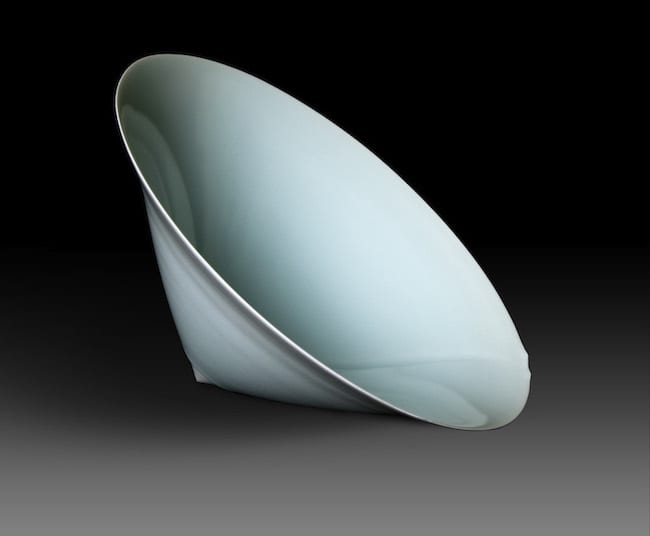Ancient works of art can inspire us thousands of years later with their surprising modernity. Similarly, the work of certain contemporary artists can transcend their period, nationality and even medium. This is true of the powerful ceramic sculpture of Sueharu Fukami, whose work is elegantly presented in an exhibition Porcelain Sculptures, 1980 – 2014 with an accompanying catalog at Erik Thomsen Gallery (New York, September 16th – through October 31st)
Above image: Sueharu Fukami, Chū (Midair), circa 2005, wheel-thrown porcelain with pale-blue glaze, 6 3/4 x 10 1/2 x 8 inches
The first piece one encounters upon entering the gallery is a nearly six-foot tall vertical porcelain blade, “Kei-II”, flawlessly covered in a translucent pale-blue celadon glaze, and impossibly balanced on a thin metal rod on a granite base. (This piece was previously on long-term loan and exhibition at the Metropolitan Museum of Art.) It gracefully torques up to a perfect point, and like all successful forms, its lines spiral out beyond its physical self, exciting the imaginations of its viewers.

Sueharu Fukami, Kei II (Landscape II), 2002, pressure-slip-cast porcelain with pale-blue glaze, on granite base, 71 inches
Anyone who has worked with porcelain will recognize the technical bravura with which Fukami executes these enormous, pressure slip-cast forms. The rest of us just stand in awe of their beauty.
Fifteen blade sculptures, dating from 1991 to present day and varying in size from 28 inches to 78 inches, both vertical and horizontal in orientation, fill the gallery. This represents an enormous accomplishment for dealer Erik Thomsen, as acquiring even one of these works would be an achievement. This exhibition has the quality of a studied museum show and, indeed, many of the sculptures appeared in the 2013 exhibition of Fukami’s work at the Portland Japanese Garden, in Portland, Oregon.

Sueharu Fukami, Ki Kaze ni tatsu (Spirit Rising on the Wind), 2014, pressure-slip-cast porcelain with pale-blue glaze, on granite base, 57 1/2 inches
The sole province of the Samurai class, the sword blade has a centuries-old association with power, virility and nobility in Japanese culture. Their obsessively precise craftsmanship reveals minute layers-upon-layers of finely honed metals, and with elongated curves designed for maximum blood-letting, they are the epitome of icy, stoic minimalism.
Fukami’s blades are kinetic. Like the motion of samurai swords artfully wielded, they slice, swoosh, curve and hover through space, not only engaging their viewers, but stealing their breath away with heroic grace.

Sueharu Fukami, Seijaku no toki (Moment of Silence), 2013, pressure-slip-cast porcelain with pale-blue glaze on walnut base, 10 1/2 x 34 inches

Sueharu Fukami, Senjō no kei (Landscape over the Horizon), 2014, pressure-slip-cast porcelain with pale-blue glaze on walnut base, 8 x 53 1/4 inches

Sueharu Fukami, Tenkū Haruka I (In the Sky _Far Away I), 2013, pressure-slip-cast porcelain with pale-blue glaze on walnut base, 14 3/4 x 50 inches
Also in the exhibition, a series of hand-thrown porcelain vessels and boxes drive home the point that Fukami began as a classically trained potter. Many of the vessel shapes have their origins in Song Dynasty Chinese ceramics, the same period when Fukami’s favored blue celadon “Qingbai” glaze was developed. The boxes have more contemporary forms with lids reminiscent of waves and layers of separated puff pastry. The most impressive and technically astonishing of the vessels are two large funnel-shaped bowls. They are extraordinarily thin for their size and are decorated with only a single raised ridge, like a fold-line, were they fashioned from paper.

Sueharu Fukami, Seihakuji kabin “Yū” Pale-blue-glazed Porcelain Flower Vase, “Calm,” circa 1981, wheel-thrown porcelain with pale-blue glaze

Sueharu Fukami, Hako no katachi “Kaikei” Box Form “Ocean View,” 2013, wheel-thrown porcelain with pale-blue glaze, 4 1/4 × 8 1/2 × 6 1⁄8 inches
Fukami is definitely not your average Japanese ceramic artist. The contemporary Japanese ceramic scene is often guilty of being too self-referential. It is a world where one is measured by the length of his glaze drips or subtler-than-thou texture fetishism. Fukami soars above ceramic-fetish and national stereotypes, joining the likes of Hiroshi Sugimoto and Issey Miyake, to present works of timeless genius in which material is at once crucial and immaterial.
Erik Zetterquist is a specialist in Asian ceramics and CFile’s New York Editor.

Sueharu Fukami, Ten (Firmament), 2013, wheel-thrown porcelain with pale-blue glaze, on stainless-steel base, 19 x 23 x 22 3/4 inches
Any thoughts about this post? Share yours in the comment box below.

Add your valued opinion to this post.